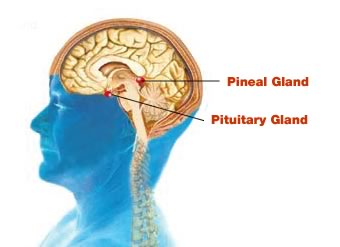Answer: The pituitary gland is responsible for releasing a variety of neurohormones related to fear, love, and stress, while the pineal gland is important for melatonin production and circadian cycle regulation.
The brain uses a variety of neurohormones to communicate with the body. These neurohormones are released into the bloodstream, and they circulate throughout the body through the blood vessels. Whereas most brain organs are separated from the bloodstream by a protective mechanism called the blood-brain barrier, a highly specialized circulatory system structure that is highly permeable, allowing the secreted hormones easy and quick access to the blood.
The pituitary gland and the pineal gland are two of the circumventricular organs that secrete neurochemicals into the blood.
The pituitary gland
Sometimes called the “master gland,” the pituitary gland is important for controlling a wide variety of physiological responses. It is located directly ventral (inferior) to the hypothalamus. It is divided into two different lobes, the anterior pituitary (adenohypophysis) and the posterior pituitary (neurohypophysis). On a gross anatomical level, the structures resemble one single structure. However, each of them operates and functions independently of the other. Additionally, they have a different site of origin developmentally. Tissue from the anterior pituitary is derived from the oral ectoderm, whereas the tissue from the posterior pituitary originates from the neuroectoderm.
The anterior pituitary (adenohypophysis) produces several classes of hormones, including luteinizing hormone (LH), growth hormone (GH), and adrenocorticotropin hormone (ACTH). Within the anterior pituitary, there are thought to be five major classes of cells, and each of them is responsible for producing a certain class of neurohormones.
The posterior pituitary (neurohypophysis) stores and secretes oxytocin and vasopressin (ADH), both of which are important neurochemical signals related to various types of attachment, such as romantic love and maternal love. Compared to the anterior pituitary, the neurohypophysis is made up of a very different type of cells. The posterior pituitary is more similar to the hypothalamus. Another distinction between the adenohypophysis and the neurohypophysis is that the posterior pituitary does not actually synthesize any hormones.
The pineal gland
The pineal gland is a neuroendocrine organ similar to the pituitary gland. It allows the brain to send neurochemical signals to the rest of the body. It largely functions to release melatonin when light stimuli from the eyes decreases. Melatonin is a neurohormone signal that triggers our bodies to get sleepier.
Photoreceptor cells in the eyes send light information into the suprachiasmatic nucleus. The light sensitive information from the retina is a signal carried via a white matter tract which is called the retinohypothalamic tract. The signal is carried by a division of the optic tract. Through a series of signaling pathways, these signals get sent into the pineal gland. When daylight is elevated, the pathway leads to an inhibition of melatonin production by the pineal gland. At night, when sunlight decreases, the photoreceptor cells are less excited. This results in disinhibition onto the pineal gland, and the increased melatonin production leads to increased sleepiness.
